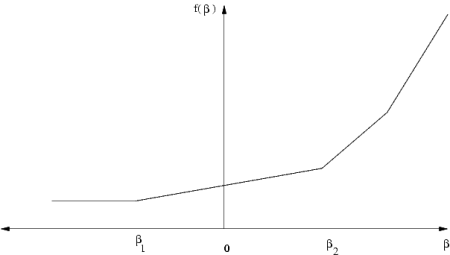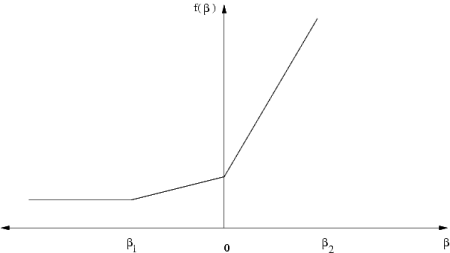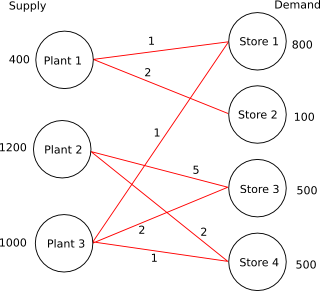14.3 Sensitivity Analysis¶
Given an optimization problem it is often useful to obtain information about how the optimal objective value changes when the problem parameters are perturbed. E.g, assume that a bound represents the capacity of a machine. Now, it may be possible to expand the capacity for a certain cost and hence it is worthwhile knowing what the value of additional capacity is. This is precisely the type of questions the sensitivity analysis deals with.
Analyzing how the optimal objective value changes when the problem data is changed is called sensitivity analysis.
References
The book [Chvatal83] discusses the classical sensitivity analysis in Chapter 10 whereas the book [RTV97] presents a modern introduction to sensitivity analysis. Finally, it is recommended to read the short paper [Wal00] to avoid some of the pitfalls associated with sensitivity analysis.
Warning
Currently, sensitivity analysis is only available for continuous linear optimization problems. Moreover, MOSEK can only deal with perturbations of bounds and objective function coefficients.
14.3.1 Sensitivity Analysis for Linear Problems¶
14.3.1.1 The Optimal Objective Value Function¶
Assume that we are given the problem
and we want to know how the optimal objective value changes as \(l^c_i\) is perturbed. To answer this question we define the perturbed problem for \(l^c_i\) as follows
where \(e_i\) is the \(i\)-th column of the identity matrix. The function
shows the optimal objective value as a function of \(\beta\). Please note that a change in \(\beta\) corresponds to a perturbation in \(l_i^c\) and hence (14.4) shows the optimal objective value as a function of varying \(l^c_i\) with the other bounds fixed.
It is possible to prove that the function (14.4) is a piecewise linear and convex function, i.e. its graph may look like in Fig. 14.1 and Fig. 14.2.

Fig. 14.1 \(\beta =0\) is in the interior of linearity interval.¶

Fig. 14.2 \(\beta =0\) is a breakpoint.¶
Clearly, if the function \(f_{l^c_i}(\beta )\) does not change much when \(\beta\) is changed, then we can conclude that the optimal objective value is insensitive to changes in \(l_i^c\). Therefore, we are interested in the rate of change in \(f_{l^c_i}(\beta)\) for small changes in \(\beta\) — specifically the gradient
which is called the shadow price related to \(l^c_i\). The shadow price specifies how the objective value changes for small changes of \(\beta\) around zero. Moreover, we are interested in the linearity interval
for which
Since \(f_{l^c_i}\) is not a smooth function \(f^\prime_{l^c_i}\) may not be defined at \(0\), as illustrated in Fig. 14.2. In this case we can define a left and a right shadow price and a left and a right linearity interval.
The function \(f_{l^c_i}\) considered only changes in \(l^c_i\). We can define similar functions for the remaining parameters of the \(z\) defined in (14.3) as well:
Given these definitions it should be clear how linearity intervals and shadow prices are defined for the parameters \(u^c_i\) etc.
14.3.1.1.1 Equality Constraints¶
In MOSEK a constraint can be specified as either an equality constraint or a ranged constraint. If some constraint \(e_i^c\) is an equality constraint, we define the optimal value function for this constraint as
Thus for an equality constraint the upper and the lower bounds (which are equal) are perturbed simultaneously. Therefore, MOSEK will handle sensitivity analysis differently for a ranged constraint with \(l^c_i = u^c_i\) and for an equality constraint.
14.3.1.2 The Basis Type Sensitivity Analysis¶
The classical sensitivity analysis discussed in most textbooks about linear optimization, e.g. [Chvatal83], is based on an optimal basis. This method may produce misleading results [RTV97] but is computationally cheap. This is the type of sensitivity analysis implemented in MOSEK.
We will now briefly discuss the basis type sensitivity analysis. Given an optimal basic solution which provides a partition of variables into basic and non-basic variables, the basis type sensitivity analysis computes the linearity interval \([\beta_1,\beta_2]\) so that the basis remains optimal for the perturbed problem. A shadow price associated with the linearity interval is also computed. However, it is well-known that an optimal basic solution may not be unique and therefore the result depends on the optimal basic solution employed in the sensitivity analysis. If the optimal objective value function has a breakpoint for \(\beta = 0\) then the basis type sensitivity method will only provide a subset of either the left or the right linearity interval.
In summary, the basis type sensitivity analysis is computationally cheap but does not provide complete information. Hence, the results of the basis type sensitivity analysis should be used with care.
14.3.1.3 Example: Sensitivity Analysis¶
As an example we will use the following transportation problem. Consider the problem of minimizing the transportation cost between a number of production plants and stores. Each plant supplies a number of goods and each store has a given demand that must be met. Supply, demand and cost of transportation per unit are shown in Fig. 14.3.

Fig. 14.3 Supply, demand and cost of transportation.¶
If we denote the number of transported goods from location \(i\) to location \(j\) by \(x_{ij}\), problem can be formulated as the linear optimization problem of minimizing
subject to
The sensitivity parameters are shown in Table 14.1 and Table 14.2.
Con. |
\(\beta_1\) |
\(\beta_2\) |
\(\sigma_1\) |
\(\sigma_2\) |
|---|---|---|---|---|
\(1\) |
\(-300.00\) |
\(0.00\) |
\(3.00\) |
\(3.00\) |
\(2\) |
\(-700.00\) |
\(+\infty\) |
\(0.00\) |
\(0.00\) |
\(3\) |
\(-500.00\) |
\(0.00\) |
\(3.00\) |
\(3.00\) |
\(4\) |
\(-0.00\) |
\(500.00\) |
\(4.00\) |
\(4.00\) |
\(5\) |
\(-0.00\) |
\(300.00\) |
\(5.00\) |
\(5.00\) |
\(6\) |
\(-0.00\) |
\(700.00\) |
\(5.00\) |
\(5.00\) |
\(7\) |
\(-500.00\) |
\(700.00\) |
\(2.00\) |
\(2.00\) |
Var. |
\(\beta_1\) |
\(\beta_2\) |
\(\sigma_1\) |
\(\sigma_2\) |
\(x_{11}\) |
\(-\infty\) |
\(300.00\) |
\(0.00\) |
\(0.00\) |
\(x_{12}\) |
\(-\infty\) |
\(100.00\) |
\(0.00\) |
\(0.00\) |
\(x_{23}\) |
\(-\infty\) |
\(0.00\) |
\(0.00\) |
\(0.00\) |
\(x_{24}\) |
\(-\infty\) |
\(500.00\) |
\(0.00\) |
\(0.00\) |
\(x_{31}\) |
\(-\infty\) |
\(500.00\) |
\(0.00\) |
\(0.00\) |
\(x_{33}\) |
\(-\infty\) |
\(500.00\) |
\(0.00\) |
\(0.00\) |
\(x_{34}\) |
\(-0.000000\) |
\(500.00\) |
\(2.00\) |
\(2.00\) |
Var. |
\(\beta_1\) |
\(\beta_2\) |
\(\sigma_1\) |
\(\sigma_2\) |
|---|---|---|---|---|
\(c_1\) |
\(-\infty\) |
\(3.00\) |
\(300.00\) |
\(300.00\) |
\(c_2\) |
\(-\infty\) |
\(\infty\) |
\(100.00\) |
\(100.00\) |
\(c_3\) |
\(-2.00\) |
\(\infty\) |
\(0.00\) |
\(0.00\) |
\(c_4\) |
\(-\infty\) |
\(2.00\) |
\(500.00\) |
\(500.00\) |
\(c_5\) |
\(-3.00\) |
\(\infty\) |
\(500.00\) |
\(500.00\) |
\(c_6\) |
\(-\infty\) |
\(2.00\) |
\(500.00\) |
\(500.00\) |
\(c_7\) |
\(-2.00\) |
\(\infty\) |
\(0.00\) |
\(0.00\) |
Examining the results from the sensitivity analysis we see that for constraint number \(1\) we have \(\sigma_1 = 3\) and \(\beta_1 = -300,\ \beta_2=0\).
If the upper bound on constraint \(1\) is decreased by
then the optimal objective value will increase by the value
14.3.2 Sensitivity Analysis with MOSEK¶
The following describe sensitivity analysis from the MATLAB toolbox.
14.3.2.1 On bounds¶
The index of bounds/variables to analyzed for sensitivity are specified in the following subfields of the MATLAB structure prob:
.prisen.cons.subuIndexes of constraints, where upper bounds are analyzed for sensitivity..prisen.cons.sublIndexes of constraints, where lower bounds are analyzed for sensitivity..prisen.vars.subuIndexes of variables, where upper bounds are analyzed for sensitivity..prisen.vars.sublIndexes of variables, where lower bounds are analyzed for sensitivity..duasen.subIndex of variables where coefficients are analyzed for sensitivity.
For an equality constraint, the index can be specified in either subu or subl. After calling mosekopt the results are returned in the subfields prisen and duasen of res.
14.3.2.2 prisen¶
The field prisen is structured as follows:
.cons: a MATLAB structure with subfields:.lr_blLeft value \(\beta_1\) in the linearity interval for a lower bound..rr_blRight value \(\beta_2\) in the linearity interval for a lower bound..ls_blLeft shadow price \(s_l\) for a lower bound..rs_blRight shadow price \(s_r\) for a lower bound..lr_buLeft value \(\beta_1\) in the linearity interval for an upper bound..rr_buRight value \(\beta_2\) in the linearity interval for an upper bound..ls_buLeft shadow price \(s_l\) for an upper bound..rs_buRight shadow price \(s_r\) for an upper bound.
.var: MATLAB structure with subfields:.lr_blLeft value \(\beta_1\) in the linearity interval for a lower bound on a varable..rr_blRight value \(\beta_2\) in the linearity interval for a lower bound on a varable..ls_blLeft shadow price \(s_l\) for a lower bound on a varable..rs_blRight shadow price \(s_r\) for lower bound on a varable..lr_buLeft value \(\beta_1\) in the linearity interval for an upper bound on a varable..rr_buRight value \(\beta_2\) in the linearity interval for an upper bound on a varable..ls_buLeft shadow price \(s_l\) for an upper bound on a varables..rs_buRight shadow price \(s_r\) for an upper bound on a varables.
14.3.2.2.1 duasen¶
The field duasen is structured as follows:
.lr_cLeft value \(\beta_1\) of linearity interval for an objective coefficient..rr_cRight value \(\beta_2\) of linearity interval for an objective coefficient..ls_cLeft shadow price \(s_l\) for an objective coefficients ..rs_cRight shadow price \(s_r\) for an objective coefficients.
Example
Consider the problem defined in (14.5). Suppose we wish to perform sensitivity analysis on all bounds and coefficients. The following example demonstrates this as well as the method for changing between basic and full sensitivity analysis.
function sensitivity()
clear prob;
% Obtain all symbolic constants
% defined by MOSEK.
[r,res] = mosekopt('symbcon');
sc = res.symbcon;
prob.blc = [-Inf, -Inf, -Inf, 800,100,500,500];
prob.buc = [ 400, 1200, 1000, 800,100,500,500];
prob.c = [1.0,2.0,5.0,2.0,1.0,2.0,1.0]';
prob.blx = [0.0,0.0,0.0,0.0,0.0,0.0,0.0];
prob.bux = [Inf,Inf,Inf,Inf, Inf,Inf,Inf];
subi = [ 1, 1, 2, 2, 3, 3, 3, 4, 4, 5, 6, 6, 7, 7];
subj = [ 1, 2, 3, 4, 5, 6, 7, 1, 5, 6, 3, 6, 4, 7];
val = [1.0,1.0,1.0,1.0,1.0,1.0,1.0,1.0,1.0,1.0,1.0,1.0,1.0,1.0];
prob.a = sparse(subi,subj,val);
% analyse upper bound 1:7
prob.prisen.cons.subl = [];
prob.prisen.cons.subu = [1:7];
% analyse lower bound on variables 1:7
prob.prisen.vars.subl = [1:7];
prob.prisen.vars.subu = [];
% analyse coeficient 1:7
prob.duasen.sub = [1:7];
[r,res] = mosekopt('minimize echo(0)',prob);
%Print results
fprintf('\nBasis sensitivity results:\n')
fprintf('\nSensitivity for bounds on constraints:\n')
for i = 1:length(prob.prisen.cons.subl)
fprintf (...
'con = %d, beta_1 = %.1f, beta_2 = %.1f, delta_1 = %.1f,delta_2 = %.1f\n', ...
prob.prisen.cons.subl(i),res.prisen.cons.lr_bl(i), ...
res.prisen.cons.rr_bl(i),...
res.prisen.cons.ls_bl(i),...
res.prisen.cons.rs_bl(i));
end
for i = 1:length(prob.prisen.cons.subu)
fprintf (...
'con = %d, beta_1 = %.1f, beta_2 = %.1f, delta_1 = %.1f,delta_2 = %.1f\n', ...
prob.prisen.cons.subu(i),res.prisen.cons.lr_bu(i), ...
res.prisen.cons.rr_bu(i),...
res.prisen.cons.ls_bu(i),...
res.prisen.cons.rs_bu(i));
end
fprintf('Sensitivity for bounds on variables:\n')
for i = 1:length(prob.prisen.vars.subl)
fprintf (...
'var = %d, beta_1 = %.1f, beta_2 = %.1f, delta_1 = %.1f,delta_2 = %.1f\n', ...
prob.prisen.vars.subl(i),res.prisen.vars.lr_bl(i), ...
res.prisen.vars.rr_bl(i),...
res.prisen.vars.ls_bl(i),...
res.prisen.vars.rs_bl(i));
end
for i = 1:length(prob.prisen.vars.subu)
fprintf (...
'var = %d, beta_1 = %.1f, beta_2 = %.1f, delta_1 = %.1f,delta_2 = %.1f\n', ...
prob.prisen.vars.subu(i),res.prisen.vars.lr_bu(i), ...
res.prisen.vars.rr_bu(i),...
res.prisen.vars.ls_bu(i),...
res.prisen.vars.rs_bu(i));
end
fprintf('Sensitivity for coefficients in objective:\n')
for i = 1:length(prob.duasen.sub)
fprintf (...
'var = %d, beta_1 = %.1f, beta_2 = %.1f, delta_1 = %.1f,delta_2 = %.1f\n', ...
prob.duasen.sub(i),res.duasen.lr_c(i), ...
res.duasen.rr_c(i),...
res.duasen.ls_c(i),...
res.duasen.rs_c(i));
end
The output from running the example in Listing 14.2 is shown below.
Sensitivity for bounds on constraints:
con = 1, beta_1 = -300.0, beta_2 = 0.0, delta_1 = 3.0,delta_2 = 3.0
con = 2, beta_1 = -700.0, beta_2 = Inf, delta_1 = 0.0,delta_2 = 0.0
con = 3, beta_1 = -500.0, beta_2 = 0.0, delta_1 = 3.0,delta_2 = 3.0
con = 4, beta_1 = -0.0, beta_2 = 500.0, delta_1 = 4.0,delta_2 = 4.0
con = 5, beta_1 = -0.0, beta_2 = 300.0, delta_1 = 5.0,delta_2 = 5.0
con = 6, beta_1 = -0.0, beta_2 = 700.0, delta_1 = 5.0,delta_2 = 5.0
con = 7, beta_1 = -500.0, beta_2 = 700.0, delta_1 = 2.0,delta_2 = 2.0
Sensitivity for bounds on variables:
var = 1, beta_1 = Inf, beta_2 = 300.0, delta_1 = 0.0,delta_2 = 0.0
var = 2, beta_1 = Inf, beta_2 = 100.0, delta_1 = 0.0,delta_2 = 0.0
var = 3, beta_1 = Inf, beta_2 = 0.0, delta_1 = 0.0,delta_2 = 0.0
var = 4, beta_1 = Inf, beta_2 = 500.0, delta_1 = 0.0,delta_2 = 0.0
var = 5, beta_1 = Inf, beta_2 = 500.0, delta_1 = 0.0,delta_2 = 0.0
var = 6, beta_1 = Inf, beta_2 = 500.0, delta_1 = 0.0,delta_2 = 0.0
var = 7, beta_1 = -0.0, beta_2 = 500.0, delta_1 = 2.0,delta_2 = 2.0
Sensitivity for coefficients in objective:
var = 1, beta_1 = Inf, beta_2 = 3.0, delta_1 = 300.0,delta_2 = 300.0
var = 2, beta_1 = Inf, beta_2 = Inf, delta_1 = 100.0,delta_2 = 100.0
var = 3, beta_1 = -2.0, beta_2 = Inf, delta_1 = 0.0,delta_2 = 0.0
var = 4, beta_1 = Inf, beta_2 = 2.0, delta_1 = 500.0,delta_2 = 500.0
var = 5, beta_1 = -3.0, beta_2 = Inf, delta_1 = 500.0,delta_2 = 500.0
var = 6, beta_1 = Inf, beta_2 = 2.0, delta_1 = 500.0,delta_2 = 500.0
var = 7, beta_1 = -2.0, beta_2 = Inf, delta_1 = 0.0,delta_2 = 0.0
